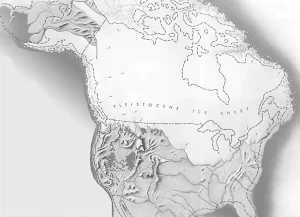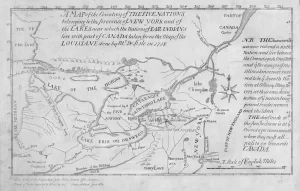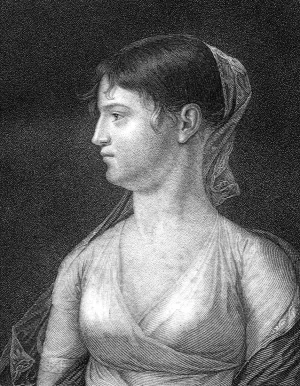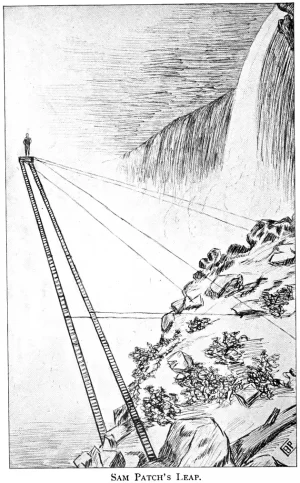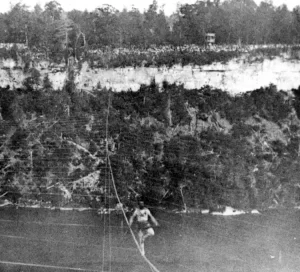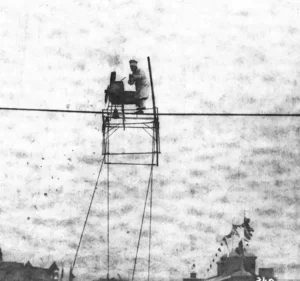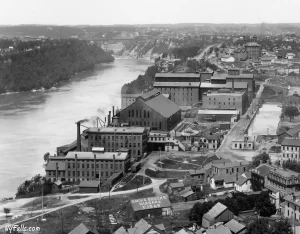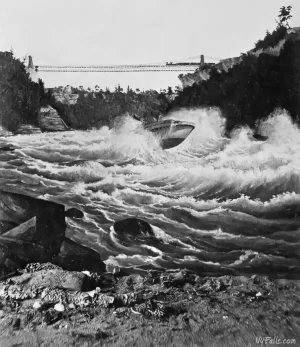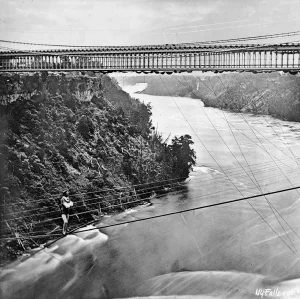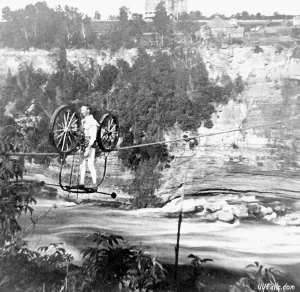Niagara Falls Historical Timeline
Niagara Falls Visitors Guide
This Comprehensive Niagara Falls Historic Timeline is a part of our Niagara Falls Guide, a comprehensive look at The Falls, top attractions, and other awesome parks in the region, with a focus on photography and nature.
Prehistoric Niagara


1600s

1608 | – |  Considered the “father of New France,” Samuel de Champlain also learns of Niagara Falls while exploring and mapping the St. Lawrence River, but never makes it there. He eventually founds a fur-trading post, which he named Quebec. A year later, he sails down the Riviere Richelieu to a large lake, which he named after himself. Considered the “father of New France,” Samuel de Champlain also learns of Niagara Falls while exploring and mapping the St. Lawrence River, but never makes it there. He eventually founds a fur-trading post, which he named Quebec. A year later, he sails down the Riviere Richelieu to a large lake, which he named after himself. |
1612 | – | 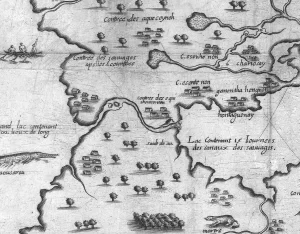 The date of the first map possibly indicating the relative position of Niagara. The map by Samuel de Champlain, who was told of, but never found the location of Niagara Falls, depicts a cataract where the Niagara River meets Lake Ontario, and has the text “sault de au.” which can be translated was waterfall. The date of the first map possibly indicating the relative position of Niagara. The map by Samuel de Champlain, who was told of, but never found the location of Niagara Falls, depicts a cataract where the Niagara River meets Lake Ontario, and has the text “sault de au.” which can be translated was waterfall. |
1626 | – | 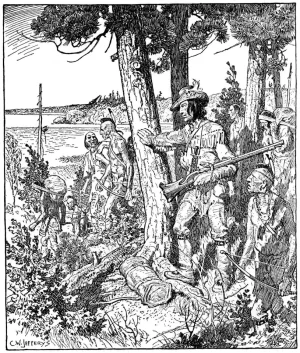 French explorer, Étienne Brûlé, was the first European to travel to all of the Great Lakes with an extended stop in the Niagara region to visit the Neutral Nation in 1626. Although there is no evidence, it is speculated that he may also have been the first to see the Falls since he was so close. French missionary Father Joseph De La Roche D’Allion may also have seen the falls during missionary expeditions targeted towards Neutral Nation settlements in the Niagara region. French explorer, Étienne Brûlé, was the first European to travel to all of the Great Lakes with an extended stop in the Niagara region to visit the Neutral Nation in 1626. Although there is no evidence, it is speculated that he may also have been the first to see the Falls since he was so close. French missionary Father Joseph De La Roche D’Allion may also have seen the falls during missionary expeditions targeted towards Neutral Nation settlements in the Niagara region. |
1641 | – | Niagara, in some anglicized form, first shows up in a map of New France. “Onguiaahra,” which may have been just a marking for the Iroquois name for the Neutrals tribe. It is not known if the position on the map refers to the falls, the tribe or the tribe’s land. The text is in the approximate position of the falls. |
1651 | – | Waging a war campaign against neighboring tribes, the Iroquois (aided with firearms obtained from Dutch traders) virtually wipe out the Neutrals and the neighboring Eries, who lived along the shores of Lake Erie in the Niagara region. |
1652 | – | Through war, the Seneca spread across the Niagara region, driving Neutral refugees toward Albany. |
1653 | – | The Neutrals are either all killed or absorbed into Iroquois tribes. |
1656 | – | 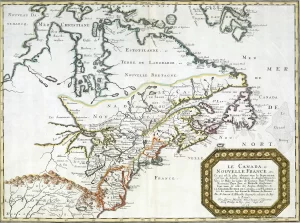 Nicolas Sanson, Geographer to the King of France, completes a map of New France, which covers all 5 Great Lakes. Niagara Falls is marked on the map as “Ongaira Sault.” Nicolas Sanson, Geographer to the King of France, completes a map of New France, which covers all 5 Great Lakes. Niagara Falls is marked on the map as “Ongaira Sault.” |
1666 | – | French explorer René Robert Cavelier, Sieur de La Salle briefly visits the Niagara region. There is no record that he had seen the falls at this time. |
December 7, 1678 | – | During an extended expedition towards Chippawa, René-Robert Cavelier, de La Salle, Father Louis Hennepin (Catholic Priest), and their crew, heard the rumble of the falls and saw the mist rising in the air as they passed the falls. They continued on to Chippawa to establish an outpost. |
December 9, 1678 | – | A guide in Cavelier’s expedition backtracked with Father Louis Hennepin and located the falls, where they watched in amazement for the whole afternoon. Hennepin, a talented illustrator, sketched the scene. He wrote of this experience, describing the falls as 600 feet high (they are actually 170). This was the first documented case of a European actually visiting the falls. Father Louis Hennepin also went on to “discover” and sketch Saint Anthony Falls in what is now Minneapolis. |
1679 | – | René-Robert Cavelier begins constructing Fort Conti at the east bank of the mouth of the Niagara River at Lake Ontario. It burned down later in the year. This fort will evolve over the years to become Fort Niagara. |
1697 | – | Father Louis Hennepin’s book Nouvelle découverte (New Discovery) was published in France. Featuring his original sketch of Niagara Falls, as well as detailed descriptions of the site, it sparked the imaginations of readers and encouraged travel to the region. |
1699 | – | Father Louis Hennepin’s book featuring the first sketch of Niagara Falls is printed in English. |
1754 | – | The French and Indian War begins. The British, American Colonials, and the Iroquois Nation fight the French and their Indian allies for territory. Fighting takes place across the Niagara region. |
1759 | – | The English, along with their Iroquois allies, attack Fort Niagara. After a 20-day siege, a British army forced the surrender of Fort Niagara from the French on July 26, 1759. Daniel Joncairs digs a small ditch to power his sawmill. This is the first recorded instance of the Falls being used as a source of power. |
1721 | – | First recorded instance of the Horseshoe Falls being referred to as horseshoe-shaped. |
1763 | – | The French and Indian War ends. The result: the British wins most of Canada. |
April 19, 1775 | – | The Battle of Lexington and Concord takes place – the first battle of the American Revolutionary War. |
1781 | – | British Loyalist, John Butler, establishes Butlersburg on the western shore of the mouth of the Niagara at Lake Ontario, across from Fort Niagara. It serves as a trading post and safe-haven for Loyalists. It is later incorporated as the capital of Upper Canada (temporarily) and eventually is renamed Niagara-On-The-Lake. From here, Butler’s Rangers perform raids on American settlements during the American Revolution. |
September 3, 1783 | – | The Treaty of Paris ends the Revolutionary war, but the New York Niagara region remains under British control. |
February 29, 1796 | – | The Jay Treaty hands over control of Fort Niagara and the surrounding land to the United States. |
1801 | – | An American aristocrat Theodosia Burr (daughter of President Aaron Burr) and Joseph Alston honeymoon in Niagara Falls and thus begin the tradition of the Niagara bridal tour. Cabins and other accommodations began to spring up in the vicinity at a rapid pace and Niagara Falls Honeymoons become the fashion. |
1804 | – | Although evidence is slim, rumor has it that Napoleon’s younger brother, Jérôme Bonaparte and his wife honeymooned at Niagara Falls. |
1805 | – | 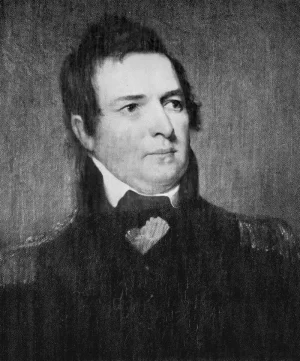 Major General, and then NY Representative, Peter B Porter and his brother, Judge Augustus Porter, of Buffalo, NY, purchased the American Falls and surrounding land from the State of New York at a public auction. There they established a gristmill and tannery to start. Over the next few generations, their family amassed a large amount of property in Niagara Falls, NY, including the Luna and Goat Island, and the rapids above the falls. Major General, and then NY Representative, Peter B Porter and his brother, Judge Augustus Porter, of Buffalo, NY, purchased the American Falls and surrounding land from the State of New York at a public auction. There they established a gristmill and tannery to start. Over the next few generations, their family amassed a large amount of property in Niagara Falls, NY, including the Luna and Goat Island, and the rapids above the falls. |
1812 | – | War breaks out between the Americans and British Controlled Canada. American leaders assume they can capture Canada at little cost. The Niagara River and surrounding region host many battles over the next 2 years. Buffalo is burned to the ground. |
July 25, 1814 | – | 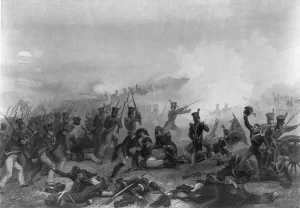 The American assault on Canada came to a halt after the Battle of Lundy’s Lane, one of the bloodiest battles ever fought on Canadian soil. After a six-hour battle, American forces retreated to Fort Erie. The War of 1812 ended shortly after. Roughly 1,500 people died. Lundy’s Lane is now an entertainment and shopping district. The American assault on Canada came to a halt after the Battle of Lundy’s Lane, one of the bloodiest battles ever fought on Canadian soil. After a six-hour battle, American forces retreated to Fort Erie. The War of 1812 ended shortly after. Roughly 1,500 people died. Lundy’s Lane is now an entertainment and shopping district. |

July 4, 1817 | – | 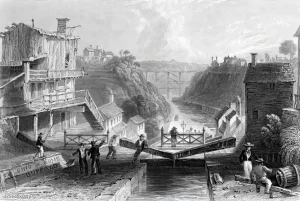 Construction begins on the Erie Canal in Rome, NY. Construction begins on the Erie Canal in Rome, NY. |
1818 | – | 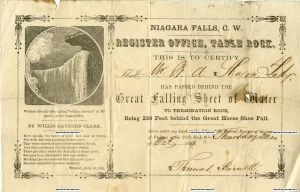 The first enclosed stairs are built on the Canadian side for the precursor to the Journey Behind the Falls attraction. It is advertised as the “Sheet of Falling Water” and admission costs $1 (equal to about $12 today). The attraction was essentially a staircase to the base of the falls at Table Rock. A small portion of Table Rock falls into the gorge. (No casualties). The Canadian territories begin developing tourist attractions and resorts. America factories and mills begin lining their side of the gorge. The first enclosed stairs are built on the Canadian side for the precursor to the Journey Behind the Falls attraction. It is advertised as the “Sheet of Falling Water” and admission costs $1 (equal to about $12 today). The attraction was essentially a staircase to the base of the falls at Table Rock. A small portion of Table Rock falls into the gorge. (No casualties). The Canadian territories begin developing tourist attractions and resorts. America factories and mills begin lining their side of the gorge. |
1820 | – | The first ferry service opened, operated by tavern owner, William Forsyth, carrying passengers across the Niagara gorge, docking just below modern-day Clifton Hill. The ferry boat was a man-powered row-boat. |
1824 | – | 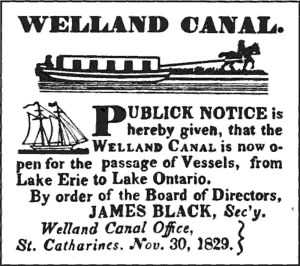 Construction begins on the Welland Canal in Canada. Paralleling the Niagara River, the canal’s purpose is to create a shipping route that avoids Niagara Falls. 7 locks are constructed to traverse the Niagara escarpment. Construction begins on the Welland Canal in Canada. Paralleling the Niagara River, the canal’s purpose is to create a shipping route that avoids Niagara Falls. 7 locks are constructed to traverse the Niagara escarpment. |
November 4, 1825 | – | 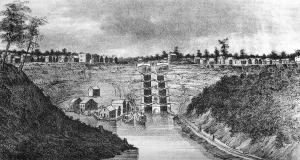 Construction is finished for the Erie Canal. The new waterway allows visitors from New York City to arrive in Buffalo within 10 days (as well as the fast transport of goods in the opposite direction). This leads to a boom in both the milling and tourism industries of Niagara. At Lockport, NY, the canal features a series of 5 locks in order to pass the Niagara Escarpment. |
1827 | – | 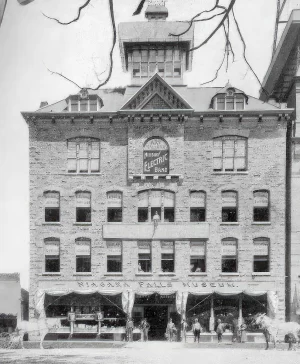 The Niagara Falls Museum opens in a former brewery in Ontario. The collection begins as an assortment of mounted local animals as well as Native American artifacts. Over the years, the museum acquires numerous oddities, including a section of one of the largest trees ever cut down, a humpback whale skeleton, and numerous Egyptian artifacts, including the remains of King Ramses I. The Niagara Falls Museum opens in a former brewery in Ontario. The collection begins as an assortment of mounted local animals as well as Native American artifacts. Over the years, the museum acquires numerous oddities, including a section of one of the largest trees ever cut down, a humpback whale skeleton, and numerous Egyptian artifacts, including the remains of King Ramses I. |
September 8, 1827 | – | 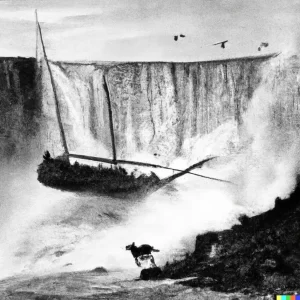 A group of entrepreneurs, led by William Forsyth of the Pavilion Hotel and founder of the first ferry service, along with John Brown of the Ontario House and General Parkhurst Whitney of the Eagle Hotel (NY), organized the first tourist stunt at Niagara Falls. They advertised the event as “The pirate Michigan with a cargo of ferocious wild animals will pass the great rapids and falls of Niagara – 8th September 1827 at 6 o’clock.” The group blocked off a significant portion of access to views of the rapids and falls, forcing visitors to pay for tickets. At that time, prior to the massive diversion of water for hydroelectric power, the water above the falls was approximately 5 meters deep, compared to today’s depth of 1 meter. This depth was deemed sufficient to carry a ship through the rapids and over the falls, or so they thought. Taking an old decommissioned lake schooner called “The Michigan,” they dressed it up as a pirate ship and stocked it with “ferocious animals.” While they advertised exotic predators such as a panther, wolves, and the like, the ship was actually stocked with only a buffalo, two small bears, two raccoons, a dog, and a goose. On September 8, 1827, at 6 pm, the Michigan was set adrift upstream from the Horseshoe (Canadian) Falls, with a crowd of about 10,000 spectators. However, before it could plummet down the cataract, the hull split open on the rocks beneath the rapids above the falls. The bears made their way to Goat Island, but the rest of the animals, who were caged or tied to the craft, went down with the ship. The goose was the sole survivor of the plunge and was later captured, becoming a tourist attraction for some time following the stunt. |
1829 | – | 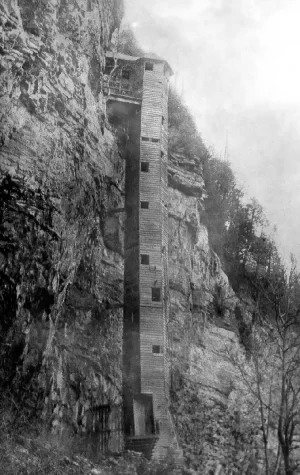 The Welland Canal opens, linking the east coast to the mid-west via the Great Lakes. The Biddle Staircase was opened in NY, allowing people to reach the base of Bridal Veil Falls and enter the Cave of the Winds. Admission was $1. The Welland Canal opens, linking the east coast to the mid-west via the Great Lakes. The Biddle Staircase was opened in NY, allowing people to reach the base of Bridal Veil Falls and enter the Cave of the Winds. Admission was $1. |
October 7, 1829 | – |
He survived but died later that year performing a second jump over the High Falls in Rochester, NY. |
1832 | – |  An upgraded, spiral staircase is constructed for the “Sheet of Falling Water” attraction. British Army officer, Captain Ogden Creighton, purchases the land surrounding Ferry Street. He begins planning the community of Clifton, named after a hillside suburb of London. |
1833 | – | The Clifton Hotel, the first “luxury” accommodation at Niagara Falls, was built at the end of Ferry Street (modern-day Clifton Hill). |
1837 | – | During the Upper Canada Rebellion, William Lyon Mackenzie, leader of the rebels, and 700 of his “Patriots,” occupied Navy Island, calling themselves “The Republic of Canada.” The Steamer Caroline, a vessel chartered by Mackenzie to run supplies, was caught by the British, set ablaze, and run over the falls. Early in 1838, the rebellion was crushed, and Mackenzie fled to the United States. |
1841 | – | The first railroad opens in Canada serving Chippawa and Queenston. Traffic is limited to horse-drawn carriages. |
May 27, 1846 | – | 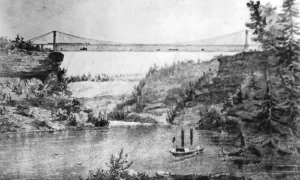 Maid of the Mist opens as a ferry service transporting people, horses, and cargo across the gorge. The company was named after a local legend about an Indian princess who canoed over the falls and killed herself to avoid marrying a man she didn’t love. The first ship was a side-wheel steamboat with twin smokestacks. At the time, it was the only direct route across the river gorge. Maid of the Mist opens as a ferry service transporting people, horses, and cargo across the gorge. The company was named after a local legend about an Indian princess who canoed over the falls and killed herself to avoid marrying a man she didn’t love. The first ship was a side-wheel steamboat with twin smokestacks. At the time, it was the only direct route across the river gorge. |
1848 | – | 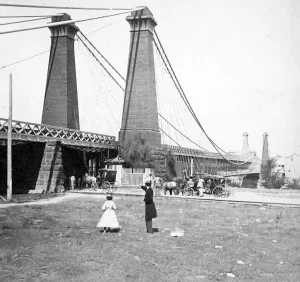 The first suspension bridge is built across the Niagara gorge. It takes business away from the Maid of the Mist ferry service, so the service begins to offer boat rides towards the Horseshoe Falls. In order to start construction of the bridge, engineers faced the challenge of running the first line across the gorge. American boy, Homan Walsh, won a contest sponsored by the engineers to send that first line over. He used a kite. Crossing the bridge was free, returning was 25 cents. The railway bridge was a temporary structure, to be replaced years later. It opened on August 1, 1848. The first suspension bridge is built across the Niagara gorge. It takes business away from the Maid of the Mist ferry service, so the service begins to offer boat rides towards the Horseshoe Falls. In order to start construction of the bridge, engineers faced the challenge of running the first line across the gorge. American boy, Homan Walsh, won a contest sponsored by the engineers to send that first line over. He used a kite. Crossing the bridge was free, returning was 25 cents. The railway bridge was a temporary structure, to be replaced years later. It opened on August 1, 1848. |
March 29, 1848 | – | 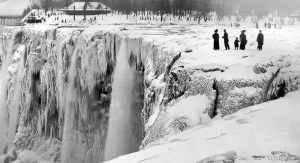 For the first time in recorded history, the falls stopped flowing. Strong westerly winds piled ice from Lake Erie at the mouth of the Niagara, near Buffalo, damming the water flow and bringing the Falls to a trickle. Residents were awakened in the night by the eerie silence and walked down to the falls to investigate. For roughly 30 hours, the falls were just dripping cliffs. It is reported that townsfolk explored the dry bed finding artifacts from the War of 1812, workers demolished boulders that made ship navigation difficult, and entertainers were quick to put on shows on the drying riverbed. For the first time in recorded history, the falls stopped flowing. Strong westerly winds piled ice from Lake Erie at the mouth of the Niagara, near Buffalo, damming the water flow and bringing the Falls to a trickle. Residents were awakened in the night by the eerie silence and walked down to the falls to investigate. For roughly 30 hours, the falls were just dripping cliffs. It is reported that townsfolk explored the dry bed finding artifacts from the War of 1812, workers demolished boulders that made ship navigation difficult, and entertainers were quick to put on shows on the drying riverbed. |
1850 | – | 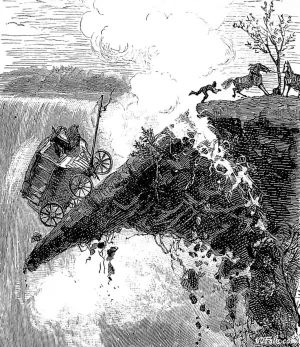 An overhanging portion of Table Rock (on the Canadian Side) falls into the gorge below. It is estimated roughly 1/3 of the total size had been lost. There were no casualties. An overhanging portion of Table Rock (on the Canadian Side) falls into the gorge below. It is estimated roughly 1/3 of the total size had been lost. There were no casualties. |
1854 | – | The Queenston/Chippawa railroad extends to serve Niagara Falls and begins using steam engines instead of horse-drawn carriages. Up until this point, most visitors would arrive by boat. |
July 14, 1854 | – | 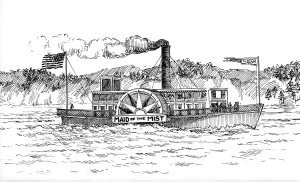 The Niagara Falls Ferry Association purchases the Maid of the Mist II, a larger, more powerful boat. It is a single-stack paddlewheeler with a 17 ft beam and a total length of 72 feet. With the launch of this more luxurious boat, the service directs its attention towards tourism rather than its diminishing ferry service. The Niagara Falls Ferry Association purchases the Maid of the Mist II, a larger, more powerful boat. It is a single-stack paddlewheeler with a 17 ft beam and a total length of 72 feet. With the launch of this more luxurious boat, the service directs its attention towards tourism rather than its diminishing ferry service. |
1855 | – | 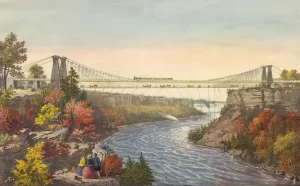 John August Roebling builds the Niagara Railway Suspension Bridge, the first rail bridge to cross the gorge. The arrival of better rail systems led to a drastic decline in boat traffic. John August Roebling builds the Niagara Railway Suspension Bridge, the first rail bridge to cross the gorge. The arrival of better rail systems led to a drastic decline in boat traffic. |

Summer 1859 | – |
|
Summer 1860 | – |
|
August 15, 1860 | – | 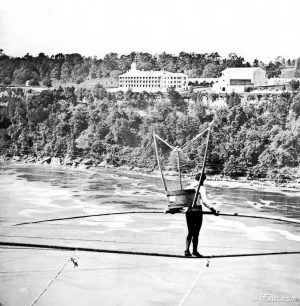 Ontario native William Leonard Hunt, “The Great Farini” tightrope walks over the gorge below the falls. Inspired by the earlier walks of the Great Blondin, he shows off by stopping mid-way and using a second rope to lower himself down to the deck of the Maid of the Mist. After sipping a glass of wine, he climbed back up and continued his walk. He then backtracked blindfolded with baskets on his feet. Ontario native William Leonard Hunt, “The Great Farini” tightrope walks over the gorge below the falls. Inspired by the earlier walks of the Great Blondin, he shows off by stopping mid-way and using a second rope to lower himself down to the deck of the Maid of the Mist. After sipping a glass of wine, he climbed back up and continued his walk. He then backtracked blindfolded with baskets on his feet.For weeks he continued tightrope walking, and attempting to top Blondin’s antics with his own. He crossed with a man on his back, with a sack over his entire body, doing summersaults while on the rope, hanging from it by his feet, and while doing laundry with a washing machine on his back. |
September 14, 1860 | – | The Falls are illuminated for the first time to celebrate the visit of the Prince of Wales. The lighting used to illuminate the falls are limelights, requiring no electricity. The color: white. |
1861 | – |
|
June 6, 1861 | – |
|
June 15, 1865 | – |
|
August 25, 1869 | – |
|
August 25, 1873 | – | Englishman Signor (Henry) Bellini tight rope walks over the gorge below the falls. He gets half way and dives to the water below, where a boat waits to pick him up. He repeats this stunt twice more in 1873. He survives. |
July 8, 1876 | – | Maria Spelterini, an Italian highwire walker, is the first (and only) woman to cross the Niagara gorge on a tightrope. She crossed downstream past the lower suspension bridge, over the Whirlpool rapids. She repeated her walk 4 more times that same year, once wearing baskets on her feet, once blindfolded, and once with her feet and hands bound. She survived. |
June 26th 1878 | – | Captain J. D. Rhodes jumps from a 90 foot platform on the American side near Prospector’s Point. He survives. |
1879 | – | The Falls are illuminated for the first time by electricity in celebration of a visit by Marquis of Lorne, Governor-General of Canada and his wife Princess Louise. |
1881 | – | Irish writer Oscar Wilde calls Niagara Falls “…a bride’s second disappointment.” |
August 10, 1881 | – | Batavia, NY native David McDowell walks across the gorge balancing on the outer railing of the Falls View Suspension Bridge. He survives despite rumors that he was drunk at the time. |
July 24, 1883 | – | Captain Matthew Webb, an accomplished British sailor and swimmer, attempts to swim from the Maid of the Mist dock to the Whirlpool rapids for a $2,000 prize. Despite being the first to cross the English Channel without a swimming aid, he could not conquer the Niagara rapids. His body was recovered downstream four days later. |
1885 | – | Under order of the Ontario Government, the Niagara Parks Commission is established to the “preserve the natural scenery about Niagara Falls.” The Commission begins buying up land and demolishing businesses to create free space around the falls. The Commission is (and always has been) a self-funded organization and is not funded by tax revenue. |
June 13, 1885 | – | R.F. Carte and Frank LeBlond invest in a new steamer, resurrecting the Maid of the Mist attraction. The powerful boat was 70 feet long, made of white oak, and had a glass-enclosed captain’s cabin. The ship was able to get closer to the Horseshoe Falls than ever before, and the popularity of the attraction skyrocketed. The boat was christened “Maid of the Mist I.” |
July 15, 1885 | – | New York’s Niagara Reservation State Park is opened, the first state park in the US. It encompasses 412 acres (including Prospect Park as well as Goat and Bath Islands). Admission is free. (map) |
July 11, 1886 | – | Carlisle D. Graham, an English barrel maker who immigrated to Philadelphia, went through the rapids in a 5 foot oak and iron barrel he constructed. He successfully repeated the stunt 2 more times. |
August 8, 1886 | – | William Hazlett and George Potts successfully navigate the Niagara rapids in a barrel borrowed from Carlisle D. Graham. |
August 22nd, 1886 | – | Following another performance Carlisle D. Graham was unable to recover his barrel from the waters of the Whirlpool rapids. He offered $10 to anyone who would retrieve it for him. James Scott jumped in and never resurfaced. Boston native William Kendall successfully swims the Niagara rapids with nothing but a life preserver made of cork. |
Winter 1886 | – | Signor Bellini returns to Niagara to jump from the Upper Suspension Bridge. He seriously injures himself and is rescued. He survives. |
1887 | – | One of the first electric streetcar systems was implemented in Niagara Falls, ON. A total of 4 electric rail systems would be implemented over the next 13 years. As the automobile became more popular, the streetcars began to struggle and eventually failed. The “Sheet of Falling Water” spiral staircase is replaced with a hydraulic elevator. Circus performer and Blenheim, Ontario native Charles Cromwell successfully crosses the gorge on a tightrope. He returns in 1890 to do it again. He survives. |
June 22, 1887 | – | Stephen Peer, inspired by Blondin, seeks becoming the first local resident to walk across the gorge on a tightrope. After working as an assistant to Signor Bellini, he makes a first attempt using Bellini’s own equipment, which supposedly drove Bellini mad – mad enough to try to cut the rope and send Peer plummeting. Spectators caught Bellini and drove him out of town. Two days later Peer was found dead at the bottom of the gorge. It was speculated that after a night of drinking with buddies, he decided to give it a go and fell to his death. |
May 24, 1888 | – | The Niagara Parks Commission in Ontario opens the first recreational area, named for Queen Victoria. The first park encompasses 154 acres and would grow over the years to be an extensive system of parks (4,250 acres total as of 2008). (map) |
1889 | – | The first tunnels were dug for the “Sheet of Falling Water” attraction. Visitors would be guided through via lantern light. |
September 15, 1889 | – | Youngstown, NY native Walter G. Campbell sets out from the Maid of the Mist dock in small wooden rowboat with just an oar, two life preservers, and his dog, Jumbo. His boat was crushed easily by the river rapids and he and his dog were thrown overboard. Carried downstream to the Whirlpool, he was able to swim to the Canadian shore and await a rescue. Jumbo did not survive. |
September 6, 1890 | – | Toronto native Samuel J. Dixon tight rope walks over the Whirlpool rapids. He returns in July of the next year to do it again. He survives. |
1892 | – | William T. Love, who owned a large portion of land along the east side of the falls, began digging a canal to surpass the falls. The canal was to be the foundation for a dream community where the rushing waters of the canal would provide nearby businesses and homes continuous, cheap power. The fourth Maid is launched: christened Maid of the Mist II. The ship is an 89 foot long steamer made of white oak, with a 19 foot beam and dual engines. |
March 17, 1892 | – | The city of Niagara Falls, NY is incorporated. |
May, 1892 | – | The American Falls are illuminated for the first time in color by the Maid of the Mist operators and the tradition of regularly lighting the falls began. |
October 12, 1892 | – | Ontario native Clifford Calverly sets the speed record for crossing the gorge on a tightrope. The record: 2 minutes, thirty-two seconds. A tenth of the speed it usually takes. He survives to make several more successful crossings. Dubbed the “American Blondin” he reenacts many of the stunts performed by the original Blondin. |
1892 | – | A small power plant is built above the Horseshoe Falls to generate DC current to run an electric train service. This is the first time the power of Niagara Falls is used to generate electricity. |
July 1, 1896 | – | At age 21, Toronto native James E. Hardy becomes the youngest person to cross the Niagara River gorge. Throughout the summer he makes 15 more crossings. He survives. |
April 3, 1897 | – | Calverly’s assistant D. H. MacDonald also completes a crossing using Calverly’s equipment. |
September 7, 1901 | – | Maude Willard attempts to traverse the Niagara rapids with her dog in Carlisle Graham’s barrel as Carlisle himself swam along, Maude’s dog jammed his muzzle through the only air hole. She suffocated, the dog and Graham survived. |
October 24, 1901 | – | Bay City, 38-year-old Bay City, Michigan school teacher Annie Edson Taylor became the first person to ride a barrel over the falls. She did it in a 4 foot tall oak and steel barrel with an anvil ballast. After resurfacing, she remained trapped in the Niagara until she drifted to a spot suitable for recovery. Although banged up, she survived, uttering “nobody ought ever do that again” as she emerged from the barrel. |
June 12, 1903 | – | The city of Niagara Falls, ON is incorporated. |

1905 | – | The Ontario Power Company begins drawing water from the Niagara upstream from the Horseshoe Falls to run through its Power station located at the base of the Falls. The plant was decommissioned in 1999 in order to make way for Casino Niagara, which was built uphill where the power station’s transformers were located. Plant buildings above the gorge now house lighting fixtures for the illumination of the falls. (map1, map2, photo1, photo2, photo3, photo4). |
January 1, 1905 | – | Canadian Niagara Power Company began generating electricity from its Rankine Generating Station, the first hydroelectric generating station to be built on the Canadian side of the Niagara River. The intake for the plant is located directly above the Horseshoe Falls. Many other plants follow, making more and more water bypass the falls and flow through tunnels and turbines. (aerial1, aerial2, photo1) |
November 21, 1906 | – | The Electrical Development Company of Ontario begins drawing water from the Niagara upstream from the Horseshoe Falls to run through its 137,500 hp electrical generating plant (The Toronto Power Plant). The plant is decommissioned in 1974 and is now part of Queen Victoria Park. (map,illustration1, illustration2, photo1) |
1910 | – | Advancements in alternating current made the long distance transfer of electricity a reality and the need for the William T. Love’s Canal waned. Plans were abandoned and only a ditch remained. |
June 25, 1911 | – | Oscar Williams (Wilson) performs the “Slide for Life.” He planned on sliding across the gorge using a leather strap strung across a wire spanning the gorge. He would hang on with his teeth. The stunt failed because the wire wasn’t tight enough and his weight caused it to sag as he arrived at the middle. He was stuck there for a half hour until a rope was used to lower him to the deck of the Maid of the Mist below. He survived. |
July 25, 1911 | – | English circus performer Bobby Leach goes over the falls in an eight foot steel barrel. The barrel gets stuck in a whirlpool at the base of the falls for 20 odd minutes until rescued. He survives, but breaks both his knees and his jaw. Having previously parachuted from the Upper Suspension Bridge and traversed the Niagara Rapids in a barrel several times, he returns to parachute over the falls from a plane (twice). Ironically, at the age of 70 he dies as a result of injuries from slipping on an orange peel. (photo1, photo2, photo3) |
1916 | – | Whirlpool Aero Car attraction opens. Designed by a Spanish engineer Leonardo Torres Quevedo, this cable car runs across 6 steel cables on the Canadian side of the whirlpool bend of the Niagara gorge. |
August 6, 1918 | – | During a dredging operation upstream from the falls, a scow (barge) that was being used to haul sand gets stuck on rocks or sand and the line snaps, disconnecting it from its hauling tug boat. Deckhands Gustave Loftberg (age 51) and Frank Harris (age 53) were aboard. The barge quickly floated downstream heading for the Horseshoe Falls. Luckily, the barge became stuck on a grouping of rocks just 2,500 feet upstream from the falls. A massive rescue effort was launched to retrieve the men before the barge became dislodged due to the turbulent rapids. After several hours, crews were able to extend a line and pull the two men to shore. The remains of the barge are still there, lodged on the same rocks above the Horseshoe Falls. (aerial1, aerial2, photo1, photo2, photo3) |
1920 | – | William T. Love’s land and failed canal were sold to the City of Niagara Falls to be used as a landfill for chemical waste disposal. Niagara Falls was dubbed “Baby City” as it was thought that more babies were conceived in this city than any other. Tourism in Niagara Falls Ontario increases in the 1920s and many modern attractions as well as makeshift “tourist camps” are erected. |
July 11, 1920 | – | British barber and amateur stunt performer, Charles Stephens (“Demon Barber of Bristol”), becomes the third person to go over the falls. Despite advice from veteran Bobby Leach, Stephens chose to skip some safety measures and plan appropriately for the stunt. He strapped his arms to the insides of his large Russian oak barrel, and an anvil to his feet as ballast. As the barrel hit the pool below the falls, the force of the impact sent Stephens crashing through the barrel’s bottom and to death by drowning. The barrel shattered and all that was recovered were wooden pieces and Stephens’ right arm. (photo1, photo2) |
September 6, 1920 | – | A rock fall within the Cave of the Winds kills 3. Multiple injuries reported. |
1926 | – | The Table Rock House of today was erected by Niagara Parks Commission. It served as a starting point for the Scenic Tunnels, a snack bar, souvenir shop, wash and dressing rooms. |
July 4, 1928 | – | Springfield, Massachusetts resident (originally from Quebec) Jean Lussier attempts going over the falls. Challenged by the tragedy of Charles Stephens 8 years ago he explores using a craft other than a steel or wooden barrel. He contracts the Ohio Rubber Company to build a 6 foot (diameter) rubber ball, lined with inner tubes and balanced to float right side up. Learning from previous daredevils’ mistakes, he devises a system of pumps and tanks to store extra oxygen in case he is trapped under the falls or has to await rescue. The ball takes minor damage and he survives with no major injuries. For several years he makes a living selling pieces of his successful craft. After running out of the famed rubber, he starts selling scrap rubber in its place. (photo1, photo2, photo3, photo4) |
July 4, 1930 | – | In hopes of raising money and awareness to publish a book on ‘metaphysical experiences,’ Greek immigrant and Buffalo, NY chef George Stathakis and his pet turtle go over the falls in a massive 2,000 pound wood and steel barrel. The barrel gets trapped behind the falls and is pummeled by the curtain of water for nearly 22 hours. By the time rescuers got to him he was dead. It was assumed that he survived the plunge, but his barrel only held enough air for 8 hours. His pet turtle survived. Niagara daredevil stunts would run dry for 21 years afterward. (photo1, photo2, photo3) |
May 25, 1931 | – | Niagara Falls, ON native William “Red” Hill Sr. finishes a trio of Niagara rapids ventures with a final trip in the very same barrel George Stathakis died in. William “Red” Hill Sr. was called the “Master Hero of Niagara,” and was considered an expert of the river’s rapids. He was famed throughout Ontario for single handedly saving the lives of a total of 28 drowning individuals in the Niagara River. His third and final trip down the rapids nearly ended tragically as Stathakis’ cursed barrel sprung a leak and became stuck within the vortex Whirlpool rapids. His son, William Hill Jr., with a rope tied around his waist, dove in to save his father. They both survived. (photo1, photo2) |
1933 | – | Ripley’s Odditorium attracts over 2 million visitors at the Chicago World’s Fair. |
1936 | – | Enrollment began for the Ontario School for Apprentice Gardeners, which eventually became the School of Horticulture/Botanical Gardens and Butterfly Conservatory. The students are responsible for maintaining the school grounds. |
September 18, 1937 | – | The Oakes Garden Theater is opened on the corner of Clifton Hill and River Road. Considered to offer the best panoramic view of the Falls, this spectacular garden encloses an open grass amphitheater. Iron gates and limestone structures enclose the garden and isolate the visitor from the busy traffic of Clifton Hill. (map) |
January 23, 1938 | – | A massive buildup of ice below the falls, combined with strong winds coming off of Lake Erie, causes severe structural damage to the Honeymoon Bridge, a steel arch bridge crossing the Niagara gorge downstream from the falls. With plenty of onlookers prepared for a show, the bridge lasts a few days and then collapses under the pressure of the ice. (3 casualties). (photo1, photo2, photo3, photo4) |
November 1, 1941 | – | The Rainbow Bridge opens, replacing the Honeymoon Bridge that collapsed 3 years earlier under the pressure of an ice jam. The Rainbow Bridge spans the length of the Niagara Gorge and is the closest bridge to the Falls. Canadian and US customs are housed inside the bridge and the complex on the Canadian side of the bridge features the Rainbow Tower, which houses a large carillon that sounds several times daily. |
1944 | – | Due to the natural recession of the Falls, new tunnels, much further back than the originals, were constructed for the “Sheet of Falling Water” attraction, which was then referred to as “Scenic Tunnels.” Electricity was run through the tunnels so visitors wouldn’t have to carry lanterns. |
July 8, 1945 | Son of the legendary daredevil hero, William “Red” Hill Jr. takes his first journey down the rapids in a steel barrel. Like his father before him, his barrel gets stuck in the vortex of the Whirlpool rapids. His brothers, Major and Norman, dive in to rescue him. He survives and repeats the stunt on September 6, 1948 and again in July of 1949. | |
1947 | – | Hooker Chemical and Plastics Corporation acquires the Love Canal property for the purpose of disposing toxic waste. |
1949 | – | Louis Tussaud’s Waxworks opens on Clifton Hill, becoming the first wax museum in Niagara Falls, ON. |
1950s | – | Chemical plants, factories and the US military begin disposing of toxic waste in mass quantities into the Niagara Gorge. The surrounding municipalities continue releasing raw sewage into the Niagara River. The practice continues throughout the next 2 decades. Fish and waterfowl populations begin to wane. It isn’t until the environmental movement of the late 1980s that laws are either enacted or enforced to cut off these sources of pollution. As a result of decades of poor environmental protection, the Niagara River and specifically the Niagara Falls area, today has one of the highest concentrations of toxic waste sites in North America. Currently toxic substances from decommissioned plants and disposal sites continue to seep into the river. |
1950 | – | The Ontario Hydro Floral Clock is completed. (map) |
August 5, 1951 | – | Facing financial problems as well as feeling the need to fill his father’s shoes, William “Red” Hill Jr. goes over the Horseshoe Falls in a cheaply built device he dubbed “The Thing.” The craft was actually 13 strapped-together inner tubes and an outer wrapping of fishing net. It was easily torn apart by the force of the falls. His body was recovered the next day. Shortly afterward, the Ontario government officially decreed that stunting within the park was illegal. (photo1, photo2) |
1952 | – | Hooker Chemical and Plastics Corporation fills the Love Canal ditch to capacity with an estimated 22,000 tons of toxic materials. The site is capped with a clay covering and closed. |
1953 | – | A series of coffer dams block water from the western-most edge of the Horseshoe Falls so the Niagara Parks Commission can repair and reinforce the portion of the falls closest to Table Rock. In desperate need of land, the Niagara Falls School Board insists on the sale of adjacent Love Canal land to the board for the construction of a new school. They purchase the land for $1 and receive a disclaimer that the land is contaminated and not to build on it. Construction is relocated when contractors dig into pockets of toxic waste. Unfortunately, the building site is relocated directly on top of the capped canal. During the construction, contractors break the seal. This school and about 100 homes are built on this site. The film “Niagara” is released starring Marilyn Monroe. |
July 24, 1954 | – | A large rock fall occurs at the observation platform at Prospect Point. Nearly 200,000 tons of rock fall into the gorge. (photo0, photo1, photo2, photo3) |
1955 | – | Due to unexpected rock collapses and the potential for serious injuries, Niagara Reservation Park officials use controlled dynamite blasts to destroy the remains of the Cave of the Winds. The tour no longer goes behind Bridal Veil Falls. |
April 22, 1955 | – | While prepping for the upcoming season, a welder’s torch sparks a fire that sets both Maid of the Mist boats ablaze. Both boats are destroyed in the fire. Salvaged wood was used to create wooden nickels to offer visitors a reserved space on a future boat. Most people kept the nickels as commemoratives. (photo1, photo2, photo3, photo4, photo5, photo6, photo6) |
July 28, 1955 | – | An all-steel, open yacht was launched to replace the destroyed Maid of the Mist boats and save the season for the company. The boat was 66 feet long, with a 16 foot beam, and dual 200 horsepower engines. It was able to carry 101 passengers. It was christened “The Maid of the Mist I.” (photo) |
June 1956 | – | The second modern Maid of the Mist is launched, christened as “The Maid of the Mist II.” It serves until 1983, when it is sold and eventually winds up in the Amazon River as a missionary boat. (photo) |
June 7, 1956 | – | A rock side leads to a large portion of the wall of the Schoellkopf Power Plant collapsing into the Niagara River. 29 workers escaped, 1 fell into the river below and died. An estimated $8 million in damage is done in minutes. When built in the early 1900s, the plant featured pen stock tubes that carried the water down the outside of the gorge. Future pen stocks were tunneled into the rock face to hide them for aesthetic reasons, thus weakening the structure and leading to this disaster. (photo1, photo2) |
1960s | – | Development and construction of various Clifton Hill museums begins. |
July 9, 1960 | – | 7-year-old Roger Woodward and his sister, seventeen-year-old Deanne Woodward, were taken on a boat ride in the upper Niagara River by a local man named James Honeycutt. The boat’s motor failed and the boat capsized, sending its passengers into the water rapidly approaching the cataract. Honeycutt was swept over the Falls and died. His body was found four days later. Deanne was rescued from the water just meters from the brink of the Canadian Falls. Roger, who was wearing a life jacket, went over the Horseshoe Falls and miraculously survived. The crew of a Maid of the Mist boat lifted him out of the water downstream of the Falls. He suffered only a slight concussion. (photo1, photo2, photo3, photo4) |
1961 | – | Lundy’s Lane Historical Museum was established and opened in the Mackenzie House. The Niagara Game Farm opens. The original Niagara Game Farm was essentially a small zoo, a large part of which was a petting zoo. Within a few years, the marine attractions were added, and the park’s name was changed to “Niagara Marineland and Game Farm”, and by 1966 it was officially just “Marineland and Game Farm”. In the 1980s, during the period of time that Kandu the killer whale became the park’s major attraction, the “and Game Farm” part of the name was dropped. |
July 15, 1961 | – | Bronx native Nathan T. Boya (aka:William Fitzgerald) goes over the falls unannounced, becoming the first black man to tackle the falls. He does it in a 6 ft steel sphere covered in rubber and sheet metal dubbed the “Plunge-O-Sphere.” Learning from past daredevils’ mistakes, he also incorporates oxygen tanks that would allow him to survive over 30 hours inside the ball. On the way down, the ball hit a rock near the American side, resulting in a massive dent. After the plunge, he was picked up by the Maid of the Mist and arrested and fined $100. He claimed he did not do it for fame or fortune, but for personal reasons. It has been speculated that he did it to impress a girlfriend. (photo1, photo2, photo3, photo4, photo5) |
1962 | – | Seagram Tower, known now as the Konica Minolta Tower opens on the Canadian side. It is the first modern observation tower to open in Niagara Falls. Over the years, due to multiple bankruptcies and ownership changes, tower names changed between Heritage Tower (1969), Royal Inn Tower (1971), Royal Center Tower (1972), Panasonic Tower (1973), and Minolta Tower (1984). It features an indoor observation deck, restaurant, wedding chapel, and hotel. From street level, the tower is 325 feet tall, however it is situated 525 feet above the falls. |
1963 | – | Ripley’s Believe It Or Not Museum opens on Clifton Hill, housing an impressive collection of the odd, strange and unbelievable from around the world. The museum showcases over 700 mind boggling exhibits, oddities, curiosities and illusions throughout their extraordinarily themed galleries. |
1965 | – | The Hollywood Wax Museum opens on Clifton Hill. |
October 6, 1965 | – | The Skylon Tower opens. Costing $7 million at the time of its construction, the Skylon Tower was owned by a private partnership called Niagara International Centre, which was financed by the The Hershey Company shareholdings of Charles Richard Reese. The tower rises 520 feet from street level and 950 feet above the falls. It features a mall, observation deck, 2 restaurants (one of which rotates), and scenic “yellow bug” elevators that climb the exterior. |
June 12 through November 27, 1969 | – | The US Army Corps of Engineers coffer dammed the American Falls, as part of a study of the rock layers behind the falls, to determine possible actions to prevent further erosion. They also explored the idea of removing the large boulders at the base to improve the look of the falls. The water was diverted to flow both over the Horseshoe Falls and to the Robert Moses generating plant’s upriver intakes. The dewatering left the river bed above the falls nearly dry and only two small segments of the falls still carried water. Record numbers of tourists came to see the dry falls, with a new, temporary attraction opening for the summer: a walk across the dry river bed. In the end, no action was taken to “improve” the falls. (photo1, photo2, photo3, Article1, Article2, Article3) |
June 13, 1972 | – | The Maid of the Mist III is lowered by crane into the Niagara gorge (the previous boats were assembled on the docks along the shore). The new Maid is 65 feet long, 65 tons, with dual 250 horsepower engines and a second deck to allow for upwards of 210 passengers. (photo1) |
June 4, 1975 | – | Franciscan Henri Rechatin, his wife Janyck, and motorcycle racer Frank Lucas make an unauthorized crossing of the Whirlpool gorge on one of the Spanish Aero Car cables. Frank Lucas drove a modified motorcycle with Henri standing on the back and Janyck hanging on to a rig below. Near the other side, Henri dismounted the cycle and walked the rest of the way. They were denied official permission to perform stunts at Niagara on multiple occasions and had to sneak in this stunt without much of a public announcement and before the Aero Car ride opened in the morning. When they reached the other side, they had no way of exiting the terminal so they waited for the operator to arrive. The operator returned them to the south side of the gorge, where they were arrested but not charged. (photo1) |
July 4, 1975 | – | A movie production company, with permission from the Parks Commission, begin filming a scene for the TV movie The Great Niagara, where a makeshift raft would carry a dummy through the Whirlpool Rapids. At the last minute stuntman Jim Sarten takes the dummy’s place. Battered by the rapids, he requires rescuing and resuscitation. He survives and retires. |
August 29, 1975 | – | Niagara Gorge River Trips Inc. tests a new rubber craft for their planned Whirlpool rapids tour. With 33 people aboard, the craft capsizes in the rapids and a massive rescue effort is launched. Three die. |
1976 | – | The Niagara Parks Commission and New York State Office of Parks, Recreation and Historic Preservation jointly review this issue of allowing daredevil and “carnival” stunts to continue. |
May-June 1976 | – | Henri Rechatin returns to Niagara to perform tightrope walking acts over Clifton Hill for the museums. |
June 18, 1976 | – | The Maid of the Mist IV is christened. The new Maid is the largest yet at 72 feet long, 74 tons, with dual 250 horsepower diesel engines, and wider dual decks to allow for upwards of 300 passengers. The boat is still running the Niagara waters today. |
June 11, 1977 | – | Hamilton, ON resident and professional stuntman Karel Soucek rides a steel barrel through the Niagara Rapids and gets stuck in the Whirlpool. After his rescue he is arrested and charged. |
August 1, 1978 | – | The New York Times breaks the Love Canal story documenting links between toxic contamination and birth defects, infections, miscarriages, cancer, asthma and other illnesses that plagued the neighborhood. |
August 7, 1978 | – | Jimmy Carter declares a federal emergency for the Love Canal neighborhood. The closest residents are relocated. |
May 1979 | – | Maple Leaf Village, an amusement park surrounding an observation tower once owned by the Oneida Community Plate Company (and re-dubbed Kodak Tower) opens. It features a carnival midway, numerous shops, eateries and attractions, including “North America’s Largest” Ferris wheel. With an entrance on Clifton Hill, it was a popular destination for families. Falling on hard economic times in the early 1990s, it was replaced with Casino Niagara. The tower is still standing. (photo1, photo2, illustration, illustration, photo3, photo4, photo5) |
May 1980 | – | The U.S. government decides to temporarily relocate upwards of 800 more Love Canal residents. |
June 10, 1983 | – | The Maid of the Mist V is christened. The new Maid is the largest yet at 72 feet long, 24 feet wide, 74 tons, with dual 335 diesel horsepower engines. It carries up to 300 passengers at a time. The boat is still running the Niagara waters today. |
July 2, 1984 | – | Calling himself “The last of the Niagara Daredevils,” Karel Soucek ends a 23 year over-the-falls-stunt drought by going over the Horseshoe Falls in a homemade metal and plastic barrel. Careful planning and an ample supply of air made the trip a successful one. The barrel was recovered shortly after the plunge and he was treated for minor cuts and bruises. He was arrested and fined $500. (photo1, photo2, photo3, photo4, photo5) |
November 12, 1984 | – | Steven Trotter attempts to go over the falls in a barrel called “The Rig.” The barrel gets stuck on the rocks upstream from the falls and he is arrested, fined $500 and the barrel is confiscated. |
August 18, 1985 | – | 22 year old Steven Trotter returns to Niagara Falls from Rhode Island and goes over the falls in a craft made from two plastic barrels, fiberglass, balsa wood (for floatation) and an exterior of inner tubes. The interior was lined with shock absorbing foam and was equipped with oxygen tanks, flashlights, a two-way radio and lifejacket. He becomes the youngest person ever to go over the falls in a barrel and the first American in 25 years. Upon recovery, he was arrested and fined $500. The former bartender became an instant media sensation, appearing on various talk shows and on the covers of a few magazines. (photo1, photo2, photo3, photo4, photo5) |
October 5, 1985 | – | John David Munday goes over the falls. An Ontario native, he is a mechanic, skydiving instructor, and pilot. Months earlier he makes his first attempt, but the park police saw him arrive at the river with his craft and the power authority was able to reduce the water flow over the falls enough to strand Munday’s craft before it went over. In October, Munday made a second attempt and succeeded, despite getting stuck at the base of the falls for over an hour and needing a rescue. He became the first to video tape his own stunt with a camera he had mounted on a porthole of the barrel. He was fined $1500 for stunting and violation of probation. (photo1, photo2, photo3, illustration1) |
September 28, 1989 | – | Ex-stock car driver Peter Debernardi, and student Jeffrey (Clyde) Petkovich, take a trip over the falls in a 10 foot long steel barrel, becoming the first team to go over the falls. Their craft included a double hatch, dual portholes and 90 minutes of oxygen. It was painted with the slogan: “Don’t Put Yourself On The Edge – Drugs Kill,” a statement explaining the reason they took the trip. They both survived and attempted to make the trip again in August of 1990, but were caught prior to launching their craft. (photo1, photo2, photo3, photo4) |
June 5, 1990 | – | 28 year old Kayaking enthusiast Jessie Sharp from Tennessee rides a polyethylene sport kayak over the falls. His plan was to video tape himself going over the falls and then continue kayaking through the Niagara and Whirlpool rapids. He never resurfaced from the plunge. He did not wear a helmet thinking it may block the view of his face from the camera, nor a life vest as it may hamper his progress. (photo1, photo2, photo3, photo4, photo5, photo6, photo7) |
July 14, 1990 | – | The Maid of the Mist VI is christened. This new boat carries up to 600 passengers. It is 80 feet long, 30 feet wide, weighing 145 tons, and sporting two 350 horsepower diesel engines. The boat is still running the Niagara waters today. |
August 26, 1993 | – | John David Munday returns to Niagara to go over the falls for a second time, this time riding in a decommissioned Coast Guard diving bell with “Dave Munday challenges Niagara Falls for the last time” painted across it. He brings no spare oxygen and only a 2-way radio. The barrel gets stuck at the base of the falls and is towed back by the Maid of the Mist. Rescuers struggled to cut the bolts and free the trapped Munday. After 45 minutes he is free and alive with only minor injuries. He becomes the first person to ride over the falls twice. (photo1, photo2, photo3, photo4) |
1994 | – | Scenic Tunnels is renamed “Journey Behind the Falls“ |
June 18, 1995 | – | Steven Trotter returns to Niagara Falls and goes over the falls a second time with his girlfriend Lori Martin. His new barrel was made from 2 water heater tanks, Kevlar and foam. The barrel landed on the rocks below the falls and required a dangerous rescue. Both survived with minor injuries, were arrested and fined $5000. Trotter was given a 2 week jail sentence. (photo1, photo2, photo3, photo4,photo5) |
October 1, 1995 | – | 39 year old Californian Robert Overacker, rides over the falls in a Jet Ski. His plan, developed over the course of seven years, was to jump from the Jet Ski as it passed the crest of the falls and deploy a rocket-propelled parachute to glide safely down to the pool below. Unfortunately the parachute flew right off of his back and hit the water just before he did. Someone forgot to connect it to Overacker’s harness. His body was recovered by the Maid of the Mist crew. |
1996 | – | The Butterfly Conservatory opens in Ontario. |
November, 1996 | – | The Niagara Parks Commission denied a request for a proposed skywalk over the falls by Jay Cochrane. Commission Chairman Gary Burroughs announced “The net effect of this type of event is to encourage less qualified individuals to perform stunts or feats that put not only themselves at risk, but also those who may be involved in their rescue.” The Niagara Parks Commission prohibits stunting on all of its properties under the authority granted under Regulations of the Niagara Parks Act. Stunting now carries a maximum fine of $10,000. |
December 9, 1996 | – | Casino Niagara opens in Niagara Falls, Ontario. It is the first casino in Niagara. |
July 11, 1997 | – | The Maid of the Mist VII is christened. Unlike the previous steel boats that were lowered by crane into the Niagara gorge, this one was disassembled and brought down in 14 sections. It was then re-assembled and launched. This new boat carries up to 600 passengers. It is 80 feet long, 30 feet wide, weighing 145 tons, and sporting two 350 horsepower diesel engines. The boat is still running the Niagara waters today. |
1999 | – | The Niagara Falls Museum closes. The collection is purchased by a private collector and is moved to Toronto. (photo) |
2001 | – | The Flight of Angels balloon ride opens in NY. |
2002 | – | Bird Kingdom opens in the former Niagara Falls Museum, which was the first concrete building erected in Canada when it was built as the Spirella Corset Factory. |
2003 | – | Seneca Niagara Casino & Hotel opens in Niagara Falls, NY. The result of an agreement between the State of New York and the Seneca Tribe (in order to bypass state anti-gambling laws), the casino is expected to renew the struggling city’s economy. |
October 20, 2003 | – | Kirk Raymond Jones goes over the falls with no barrel, craft or flotation aid of any kind. He came from Michigan, unemployed and depressed, with an idea. Based on interviews with people close to him, he had planned to go over the falls to gain fame, fortune, and hopefully a job. With only the clothes on his back he went over the Horseshoe Falls near Table Rock. After the plunge he resurfaced and swam to shore where he awaited rescue. His was arrested and admitted to the psychiatric ward of a local hospital (probably because he claimed the stunt as a failed suicide attempt). Upon his treatment (for minor bruises and counseling) he was released. He was fined $3,000 plus the cost of his rescue. (article) |
June 10, 2004 | – | Niagara Fallsview Casino Resort opens in Ontario. It is the single largest provincial investment ever made in the Niagara region and is currently the largest commercial development in Canada. |
Summer 2006 | – | The Niagara Skywheel opens. Rising 175 feet (53 meters) above the eastern slope of Clifton Hill, this massive Ferris wheel offers visitors a spectacular view of the falls and surrounding attractions from fully enclosed, climate controlled cabins. The ride is open year-round. |
Summer 2007 | – | Jay Cochrane skywalks above the tourist attraction packed streets, twice a day, 7 days a week. He is rigged with a microphone and talks to the crowd as he walks. (video) |
July 2007 | – | The Niagara Parks Commission agrees to vote on Jay Cochrane‘s proposal to skywalk across the Niagara gorge. |
Winter 2008 | – | The Flight of Angels balloon ride closes. |
March 10, 2009 | – | An unnamed man went over the Horseshoe Falls in a failed suicide attempt. Rescuers pulled him from the pool below. The force of the Falls left him completely naked, in shock and with a large gash on his head. He is the third person to ever survive the plunge without a craft. |
June 15, 2012 | – | Daredevil Nik Wallenda becomes the first person to walk a tightrope across the Horseshoe Falls, about 1,800 feet (550 meters) in a little more than 25 minutes, in a globally televised event. |
Summer 2016 | – | The Mystrider zipline opens in Niagara Falls, Canada, taking riders 2,200ft along the gorge. |
Spring 2018 | – | A refurbished interactive multimedia Cave of the Winds attraction opens in New York. |
October 31, 2019 | – | Iron Scow breaks loose in a windstorm, flips over, and moves 55 yards closer to the brink of Horseshoe Falls. |
August 6, 2021 | – | Ice melt causes the Iron Scow barge wrecked to break up into pieces. |






